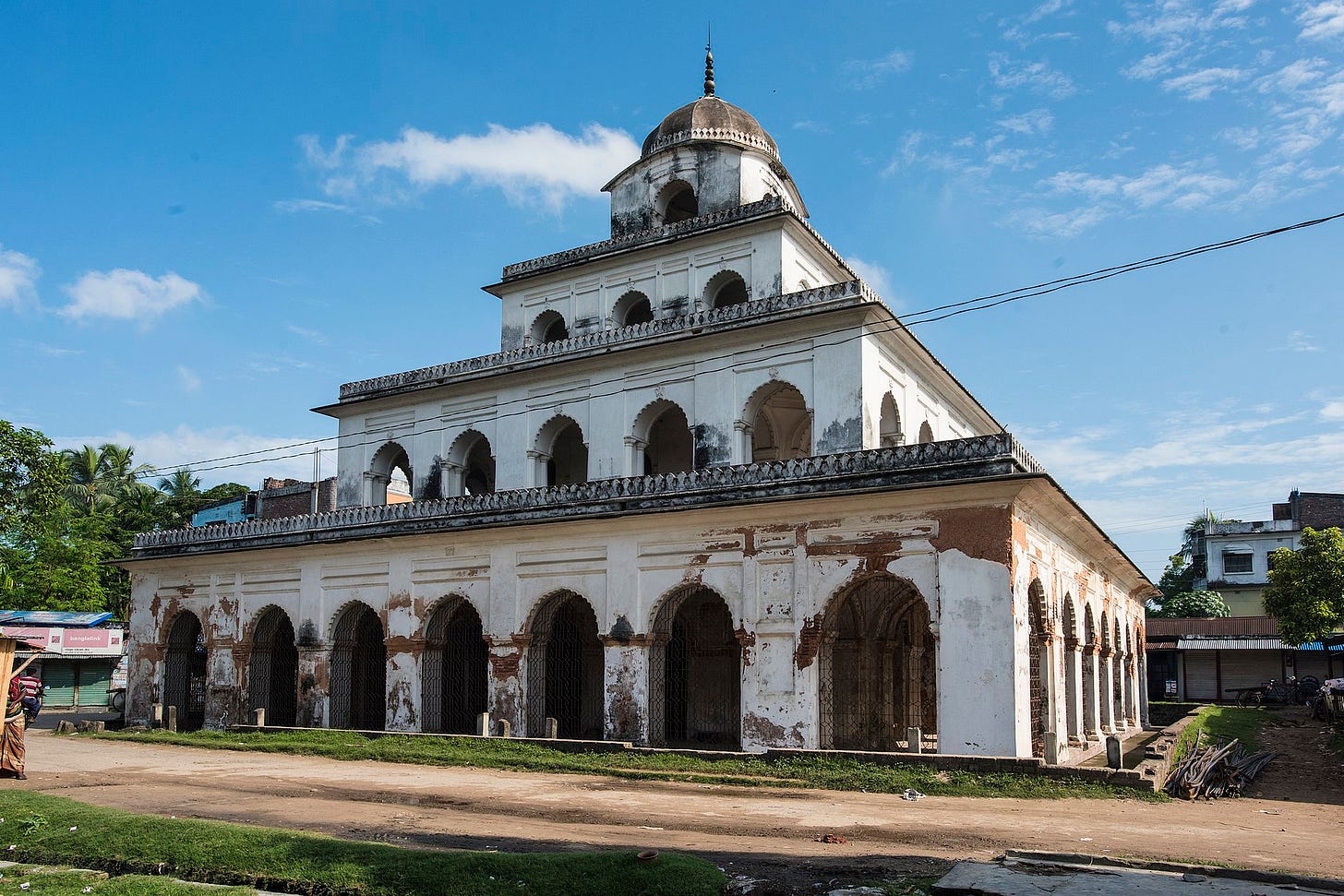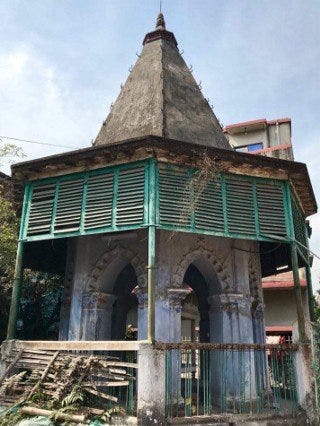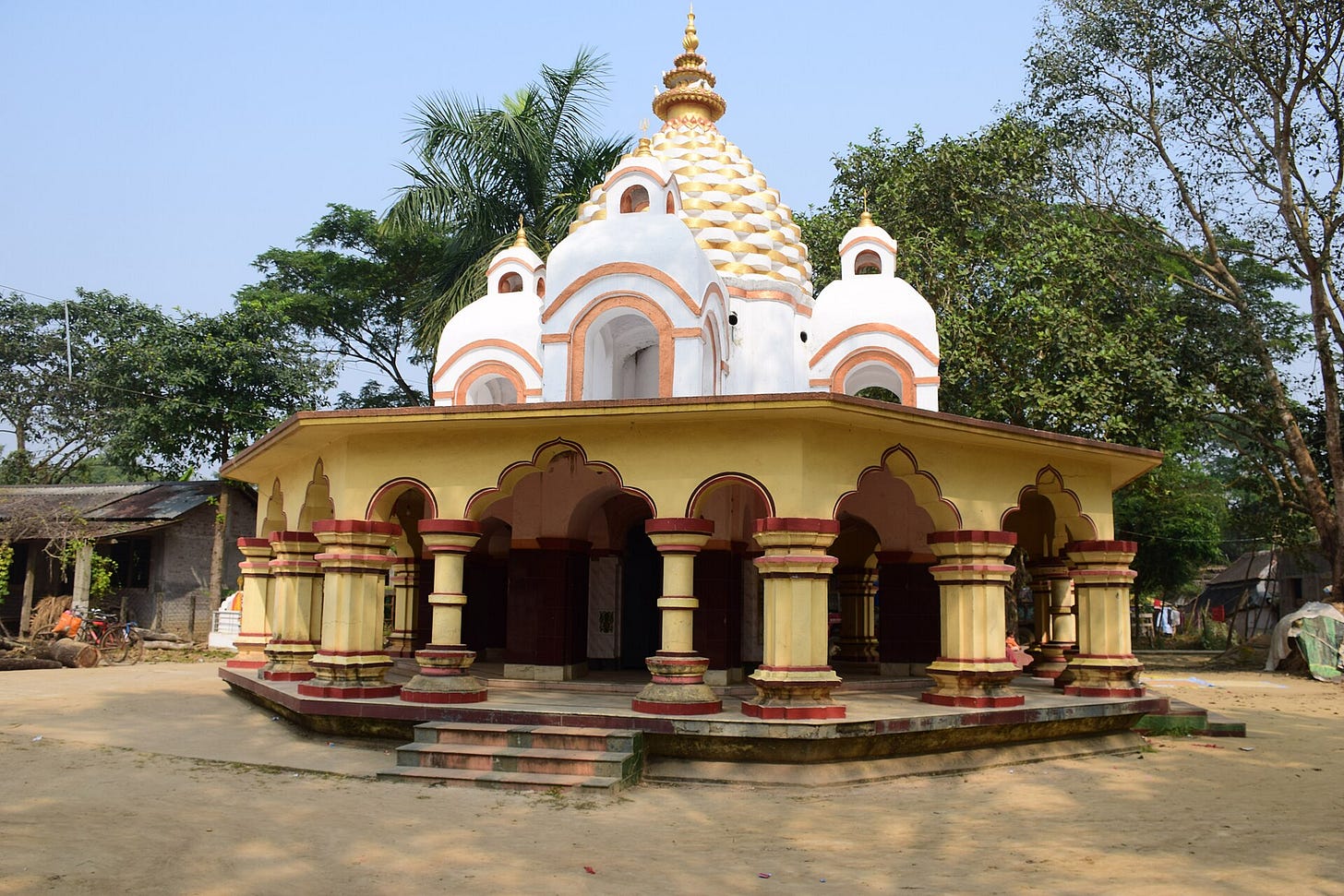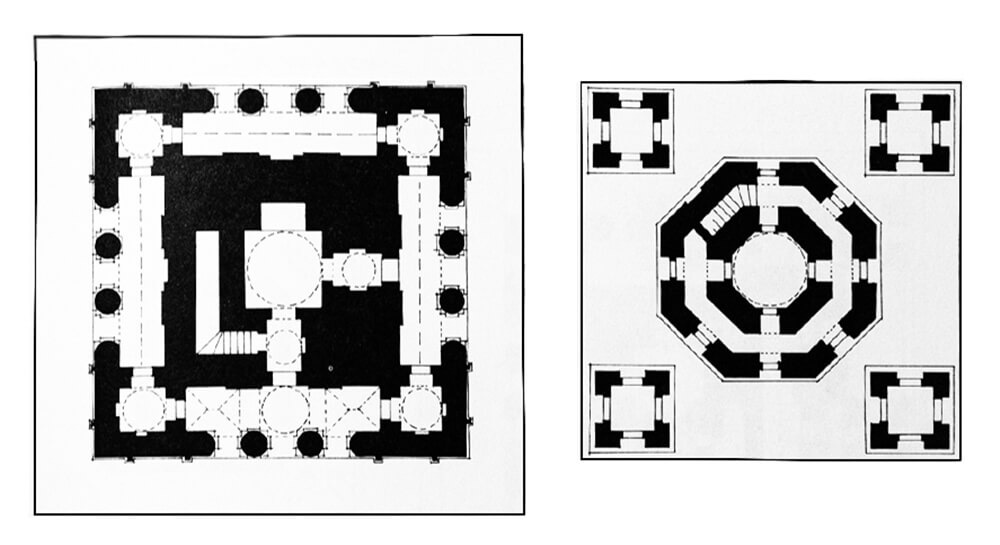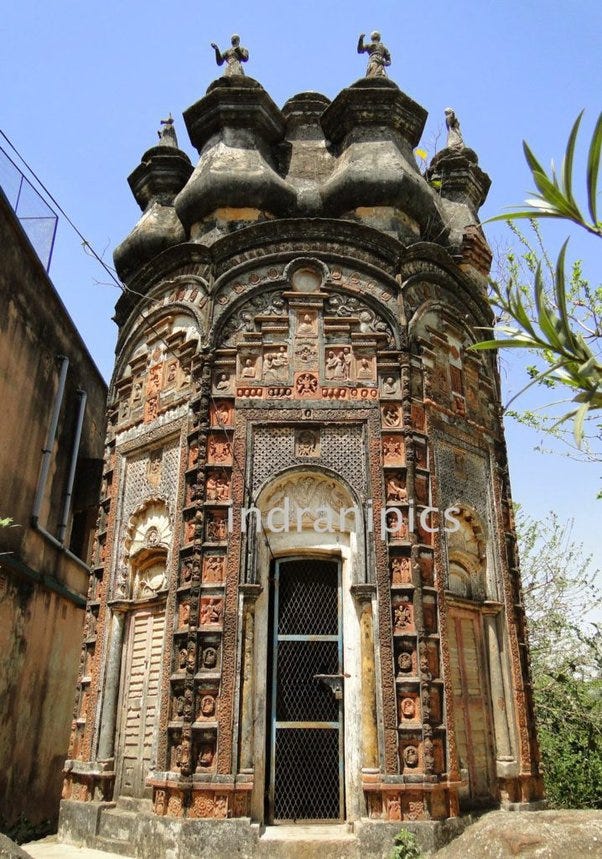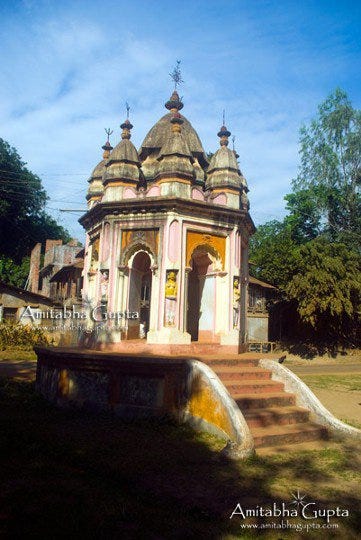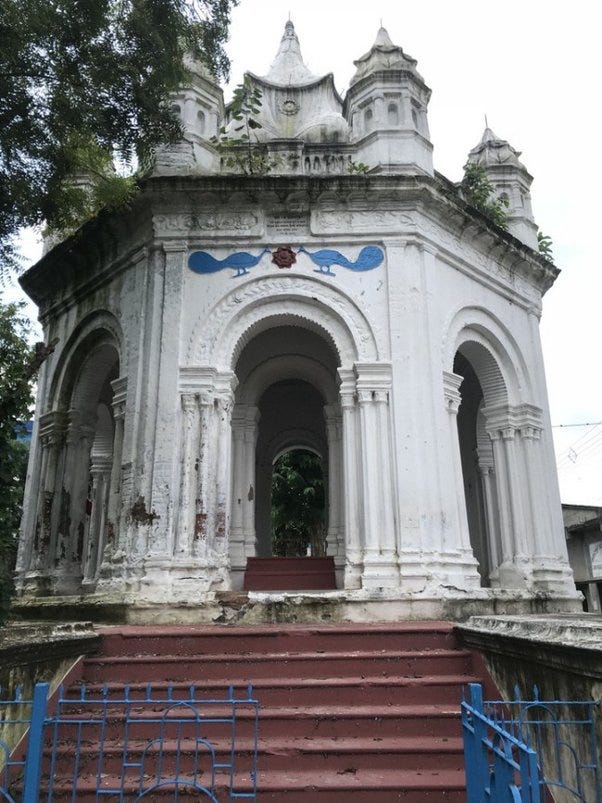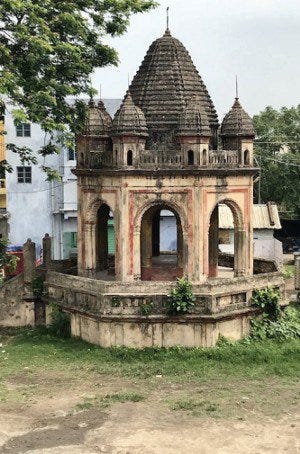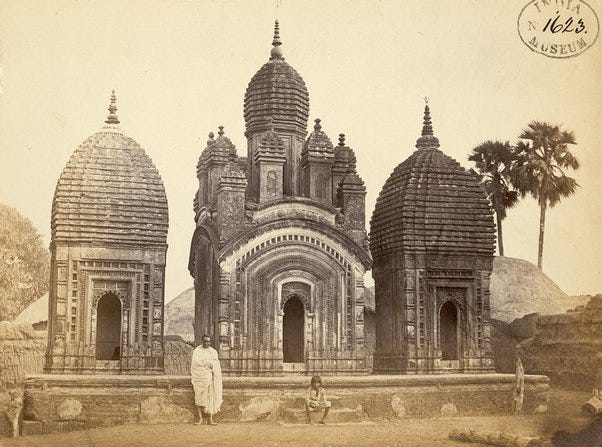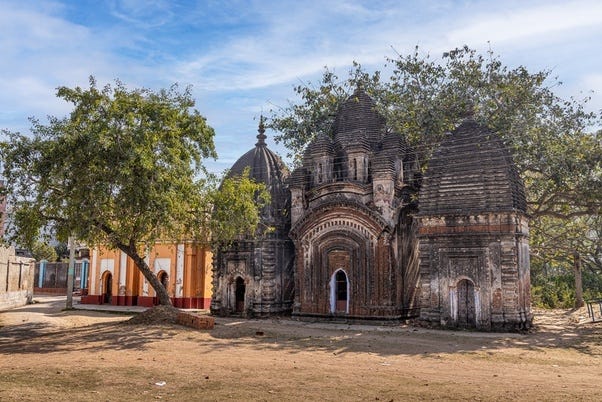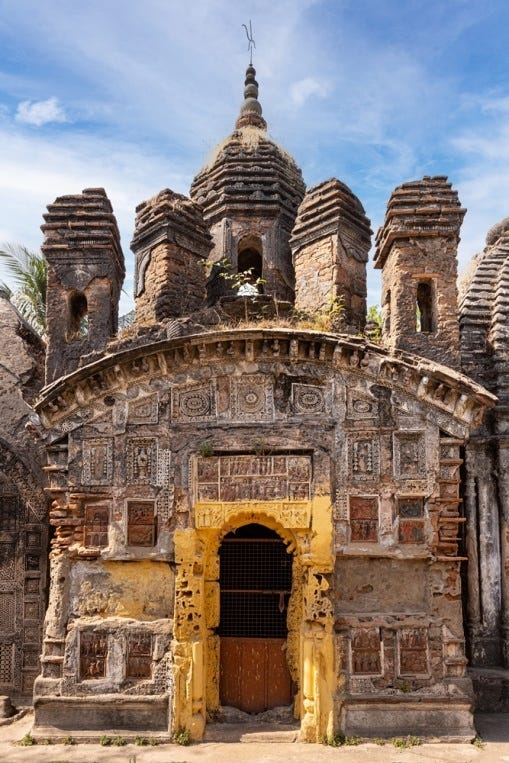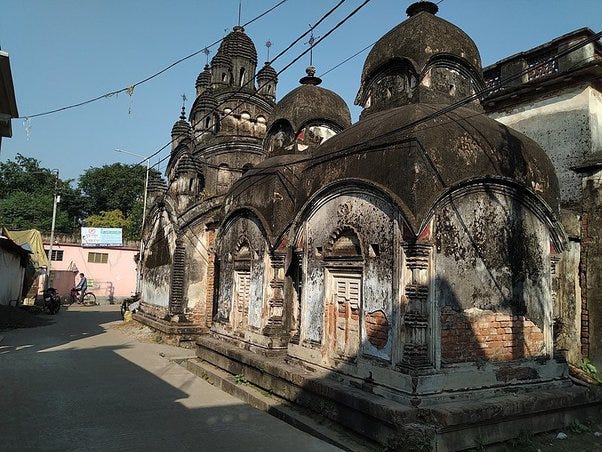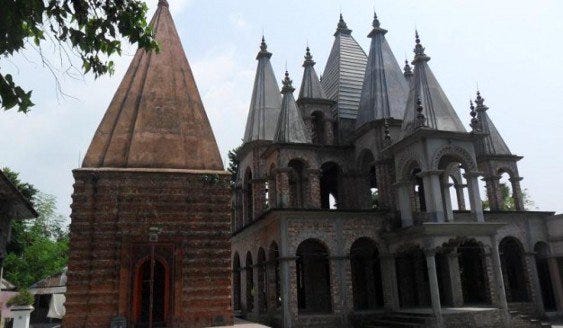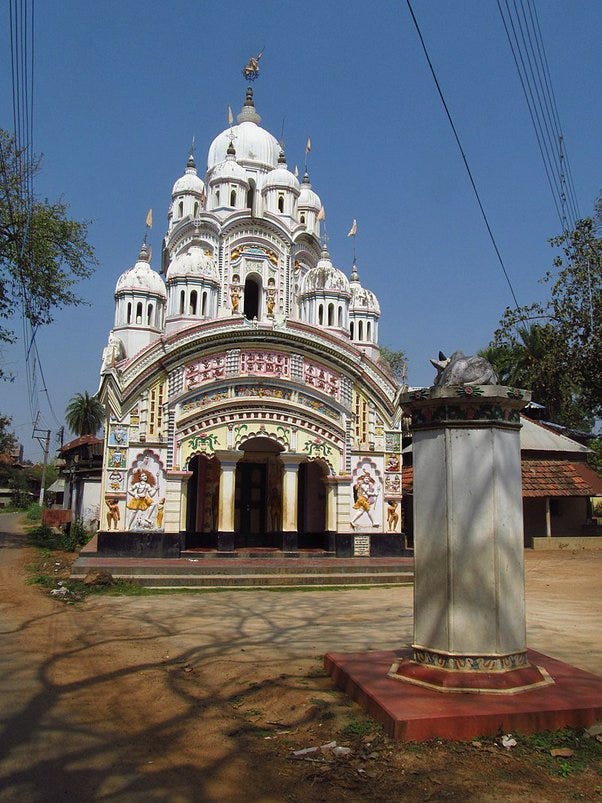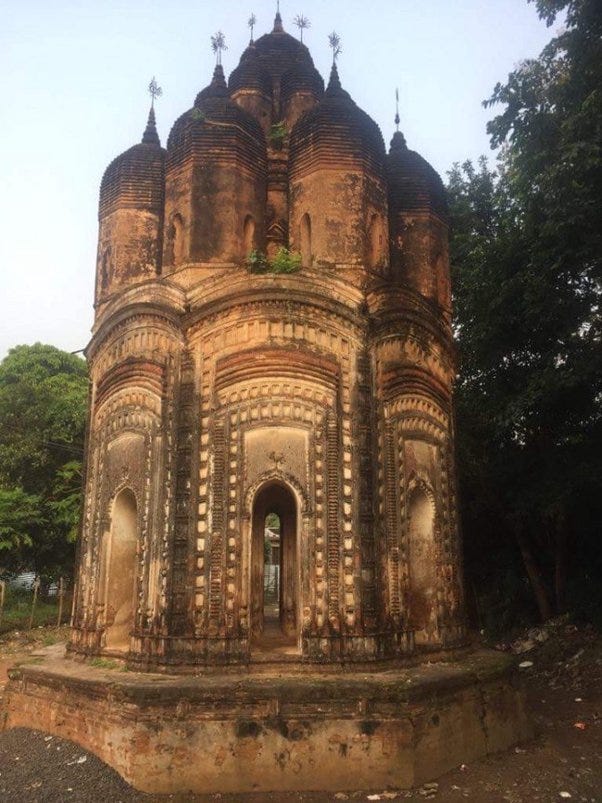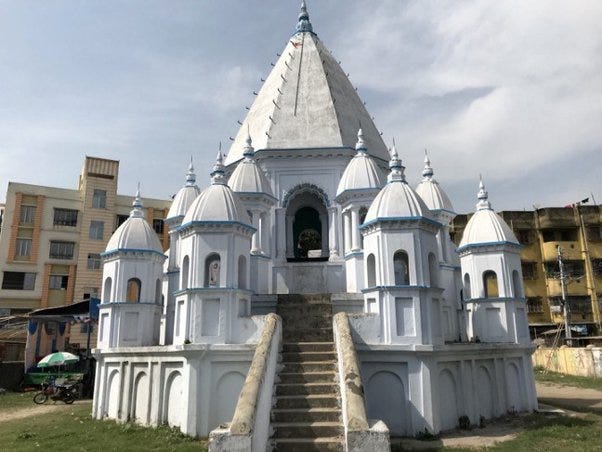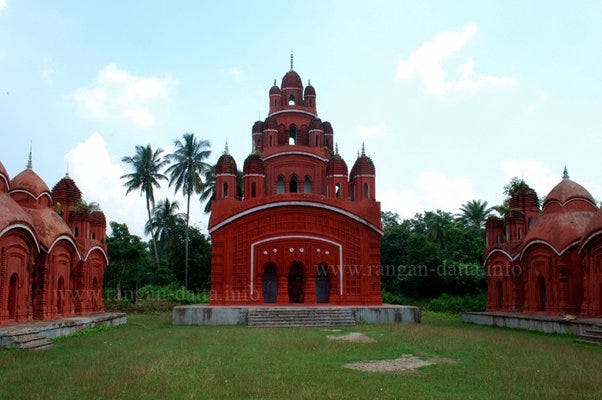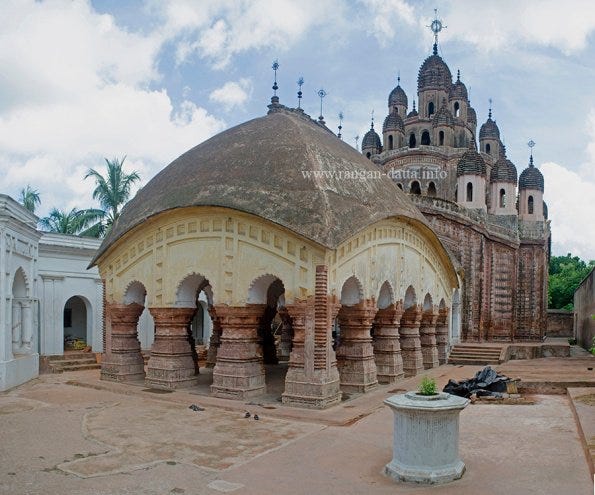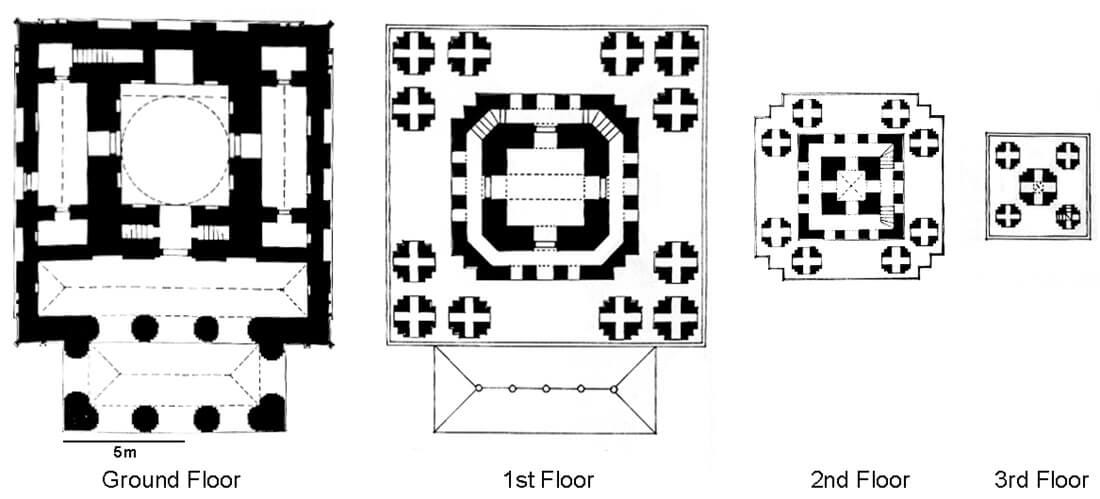Temple Architecture styles : Baṅlā Ratna architecture
This post discusses about the Ratna architecture style of Baṅlā architecture styles.
Ratna (jewel/gem) in this regard refers to the tower(s) constructed over the sanctum structure. The prefixed number designates the number of towers constructed over the temple. The base of Ratna-style temples is usually formed by either a 4-cālā structure or a flat-roofed one. This post shall not cover buildings combining Ratna styles with others, except the case of common base structures as mentioned previously.
Ratna-type Mañcas have not been covered here, since they can come in many more configurations for the same number of pinnacles than is found in temples. Shall be covered in separate post.
Introduction
The term “Ratna” in context of Baṅlā architecture styles refers to pinnacles placed over relatively large base structures, which together forms the entire structure of temple, or at least the vimāna part (that contains the sanctum).
The pinnacles themselves can come in many shapes and sizes, but most often copy the designs of Rēkhā deulas or Cālā-type temples. They may optionally contain an icon of a deity visible through the “entrance” of the pinnacle.
The ratna style came up in 15th-16th century CE. The earliest nava-ratna (9-gem) temples in Midnapore were probably in the Sabang area in the early 18th century CE.
Ēka-Ratna (1 gem)
This is the simplest design, involving a single tower over a base. But even here, quite many variations are possible.
Temples, Temple Clusters and Temple Complexes
→ Ēka-Ratna Temples and Temple Complexes examples:
Lalji Temple in Bishnupur, West Bengal, India — a 5-facet dome-topped tower over a single sloped (ēka-cālā) type structure having a triple entrance. The Ratna part can be seen having an “entrance” as well [Source: File:Radhashyam Temple - Bishnupur.jpg]
Ananta Basudeba Temple in Hooghly, West Bengal, India — an octagonal slope-roofed tower over a 4-cālā-esque structure. The temple proper has a triple entrance, while the octaginal pinnacle has 1 entrance inline with the temple’s entrances. [Source: Bengal temple architecture – historyreads]
Bishalakshmi alias Basuli Temple in Nanoor, West Bengal, India [Source: Terracotta Temples around Shantiniketan, Part III ( Nanoor and Uchkaran)]
Tripura Sundari Temple in Udaipur, Gomati district, Tripura, India — a “stacked conical” pinnacle over a 4-eave style base [Source: File:Tripura Sundari Temple, Udaipur.jpg]
Kalanjay Shiva Temple in Patrasayer, Bankura district, West Bengal, India — features a relatively large 5-facet pinnacle over a 4-eave style base with each face having pentuple-entrances [Source: Temples of Patrasayer, Bankura]
Murali Mohan Temple in Bishnupur, Bankura district, West Bengal, India — Ēk-Ratna temple with peripteros (Built 1665 CE by Queen Śirōmaṇi (alias Churamani Devi), wife of the Malla King Bīr Siṅgha II) [Source: https://kevinstandagephotography.wordpress.com/2023/10/09/murali-murli-mohan-temple-bishnupur/]
Temples at Lalmai Chandi Temple Complex on the summit of Lalmai hill in Barura Upazila of Comilla District, Bangladesh — these temples have “stacked-conical” pinnacles over a 4-eave style base. The entrance halls are also in identical style with smaller scale, and have a single entrance each. [Source: File:Front view of Chondimura temple, Comilla district, Bangladesh.jpg]
Kamaleshwari Temple Complex on a hillock near Kamalsagar artificial lake in Sipahijala district, Tripura, India — Ēka-Ratna temple with an Ēka-Ratna entrance hall and a detached Ēka-Ratna associated hall. (Built 15th century CE under Tripura kingdom ruler Dhāṉya Māṇikya) [Source: Kasba Kalibari | Kamaleshwari Temple Agartala, Timings]
Anandamoyee Kali Temple in Krishnnagar, Nadia district, West Bengal India — features a Cār-cālā Ratna over a flat base. The base has arched triple entrance flanked by faux arched entrances; the arches employ Gothic architecture elements by resting on separateby conjoined pillars. (Built 1804 CE) [Source: File:Anandamoyee Kali Temple-Krishnnagar-West Bengal-DSC 4031 00001.jpg]
Dol Mandir in Puthia Temple Complex, Puthia Upazila, Rajshahi District, Bangladesh — a domed octagonal tower over a multi-storey Dālāna-like structure [Source: https://commons.wikimedia.org/w/index.php?curid=41150007]
Rāsmañcas, Dolmañcas and Tulsīmañcas/Tulsīmandiras
→ Ēka-Ratna Rāsmañcas examples:
Rāsmañca having a single square pyramid on an octagonal base [Source: Rasmancha]
Pañca-Ratna (5-gems)
Built by placing 5 pinnacles in a quincunx fashion. The central pinnacle may be made larger than the rest 4, or placed on a separate base.
Temples, Temple Clusters and Temple Complexes
→ Pañca-Ratna Temples and Temple Complexes examples:
Kalachand Temple Complex in Pathra near Midnapore town, Midnapore district, West Bengal, India — features a single entrance at the base, while the pinnacles feature “entrances” on all 4 sides [Source: Pathra, rebirth of the temple town]
Shyam Rai Temple in Bishnupur, Bankura district, West Bengal, India. The lower pinnacles are 4-eave style with “entrances” on all 4 sides. The central pinncale is 2-storied octagonal, with “entrances”on all 8 sides. The pinnacles rest on a 2-eave style base with triple entrances. Note that one of the lower pinnacles was damaged, and repaired in different style. [Source: Bengal temple architecture – historyreads]
Bhubaneswar Shiva Mandir in Puthia Temple Complex in Puthia Upazila, Rajshahi Division, Bangladesh — the features similar type of 5 towers being of Bhūmija type (decorated with miniature spires). All 5 towers lie on a flat base [Source: File:Shiva temple at Puthia, Rajshahi.JPG]
Govinda Temple in Puthia Rajbari Complex, Puthia village, Rajshahi district, Bangladesh — the pinnacles share the same base. The smaller ones are 4-eave type with one entrance on each side, the centracle larger one is a 4-eave type with triple entrances [Source: File:Puthia Mandirs10.JPG]
Shandeswartala Temple in Chinsurah, Hooghly, West Bengal, India — the pinnacles are planar stepped-pyramidal towers; the central pinnacle is an 8-eave-esque structure. The pinnacles have no symbolic entrances [Source: Shandeswartala Temple, Chinsurah]
A 5-gem temple in Garh Panchakot, Purulia, West Bengal, India after renovation. It can be seen that the smaller pinnacle in foreground is a ridged 3-facet pyramidal type, while others (including central one) are ridged curvilinear 7-facet type. [Source: File:Pancha Ratna Temple, Garh Panchakot (After Renovation).jpg]
Sri Sri Shiv Mandir in Dhamrai, Dhaka, Bangladesh — features a relatively massive central pinnacle and tiny surrouding ones [Source: http://bangladeshtemples.blogspot.com/2015/03/sri-sri-shiv-mandir-dhamrai-dhaka.html]
Nilkantheshwari Temple at Rabindra Nath Road, Chandannagar, West Bengal, India — features pinnacles of equal sizes and at same level [Source: Nilkantheshwari Temple, Gondalpara, Chandannagar]
Ranagaswer Shiva Temple in Manoharpur, Paschim Medinipur district, West Bengal, India — octagonal Pañca-ratna with entrance below one of the subsidiary spires [Source: https://commons.wikimedia.org/wiki/File:Ranagaswer_Shiva_Temple_at_Manoharpur_in_Paschim_Medinipur_district_01.jpg]
→ Plan of lower floor (left) and upper floor (right) of Shyama Rai Temple in Bishnupur, Bankura district, West Bengal, India (Built 1643 CE by Raghunātha Simha, the 51st Malla king) [Source: https://kevinstandagephotography.wordpress.com/2024/02/08/shyam-rai-temple-bishnupur/]
Rāsmañcas, Dolmañcas and Tulsīmañcas/Tulsīmandiras
→ Pañca-ratna Dolmañcas examples:
Examples of Pañca-ratna Dolmañcas from https://kinjalbose.wordpress.com/2020/03/05/dolmancha/ [Source: Screenshots from https://kinjalbose.wordpress.com/2020/03/05/dolmancha/]
Naba-Ratna (9-gem)
Formed either by keeping a Pañca-ratna structure in centre and surrounding it by 4 spires on all corners or less commonly by surrounding an Ēka-Ratna structure by 8 spires on corners of an octagon.
Temples, Temple Clusters and Temple Complexes
→ Recursive quincunx Naba-ratna Temples and Temple Complexes examples:
Naba Ratna Temple in Pathra near Midnapore town, Midnapore district, West Bengal, India — the 4-eave main base supports the lowermost pinnacles and the smaller 4-eave base supporting the rest of the 5 pinnacles [Source: Pathra, rebirth of the temple town]
Santinath Siva Temple in Mitrasenpur area of Chandrakona, Ghatal subdivision, Paschim Medinipur district, West Bengal, India — the lowermost 4 pinnacles are octagonal, while upper 5 are faceted square but on octagon bases [Source: File:Santinath Siva temple at Mitrasenpur area of Chandrakona town in Ghatal subdivision of Paschim Medinipur district Of West Benga 13.jpg]
Annapurna Temple in Telinipara, Bhadreswar, Hooghly district, West Bengal, India — flat bases for both lower 4 and upper 5 pinnacles [Source: File:Annapurna Mandir-Bhadreswar-West Bengal-4.jpg]
Buroshib Temple in Ward No. 2, Nabadwip municipality, Nabadwip, Krishnanagar Sadar subdivision, Nadia district, Presidency division, West Bengal, India [Source: File:বুড়োশিব মন্দির.jpg]
Sonarong Twin Temples in Sonarong, Bangladesh — use a large octagonal Moth type central tower surrounded by much smaller spires on both same and lower levels [Source: en.banglapedia.org]
→ Octagonal Naba-ratna Temples examples:
Possibly the only example of a Naba-Ratna temple with central pinnacle surrounded by 8 pinnacles on an octagonal plan is Chandranath Shiva Temple of Hetampur in Suri Sadar subdivision of Birbhum District, West Bengal, India (Built 19th century CE) [Source: Chandranath Shiva Temple in Hetampur, West Bengal - i Share]
Rāsmañcas, Dolmañcas and Tulsīmañcas/Tulsīmandiras
→ Octagonal Naba-Ratna Rāsmañcas examples:
Octagonal Naba-Ratna Rāsmañca near Bali Dewanganj Temple Complex, West Bengal, India [Source: https://amitabhagupta.wordpress.com/2014/11/04/the-most-unique-brick-temple-of-bengal/]
Octagonal Naba-Ratna Rāsmañca associated with Radhaballav Tempe in Serampore, West Bengal, India [Source: Rasmancha]
Octagonal Naba-Ratna Rāsmañca in Lalbazar area, Kolkata, West Bengal, India [Source: Rasmancha]
Trayōdasa-Ratna (13-gem)
Few examples of this category exist. The count of 13 pinnacles is usually achieved by one of the following arrangements:
4 pinnacles surrounding 8 pinnacles surrounding a central pinnacle - commonly seen in Dubrajpur
8 pinnacles surrounding a 5-pinnacle structure
Recursive quincunx: 4 pinnacles surrounding a regular 9-pinnacle structure
Temples, Temple Clusters and Temple Complexes
→ 4 outer + 8 inner + 1 central tower type Temples and Temple Complexes examples:
1. The following examples are found in Dubrajpur, Birbhum district, West Bengal, India : Both temples employ a 4-Cālā structure as the base. 8 pinnacles are placed in the lower outer section, and surround a more usual 5-pinnacle structure. The central pinnacle is the largest. All the pinnacles are of Piṛhā deuḷa type — the central one is octagonal and rest are square.
[Source: Three temples at Dubrajpur, Birbhum District]
[Source: Shiva Temple at Dubrajpur, Birbhum District]]
13-ratna temple (middle foreground) of Ojhapara Temple Cluster [Source: The Terracotta Temples of Dubrajpur]
13-ratna temple of Namopara Temple Cluster with some of the pinnacles fallen [Source: The Terracotta Temples of Dubrajpur]
→ 8 outer + 4 inner + 1 central tower type Temples and Temple Complexes examples:
Hangseshwari Temple in Bansberia, West Bengal, India is achieves the 13-pinnacle arrangement using a dodecagonal plan for the lowermost 8 pinnacles, which surround an otherwise usual 5-ratna structure. [Source: File:Hangseshwari Temple1.JPG]
→ Recursive quincunx Temples and Temple Complexes examples:
3-storied 13-pinnacle Sita Rama temple in Kharar, Ghatal, Paschim Medinipur district, West Bengal, India — features recursive quincunx format of central structure surrounded by 4 pinnacles. [Source: File:13 pinnacle Sita Rama Temple of Majhi Family at Kharar under Ghatal Police Station at Paschim Medinipur district in West Bengal 14.jpg - Wikimedia Commons]
Satēro-Ratna (17-gem)
At 17 pinnacles and greater, recursive quincunx becomes too complicated. Usually temples with 17 or more pinnacles employ groups of 8 or more towers on a single storey, thereby reducing the count of storeys to 3-4.
This format seems to be more common with Mañcas buildings rather than temples. Examples of these are rare.
Temples, Temple Clusters and Temple Complexes
→ Satēro-ratna Temples and Temple complexes examples:
Jagannath Temple in Handial, Pabna district, Bangladesh (original temple built possibly in 15th century CE, current structure built 1590 CE by Bhobani Proshad)1 [Source: http://offroadbangladesh.com/places/handial-jogonnath-temple/]
Parvatinatha Temple in Chandrakona, Paschim Medinipur district, West Bengal, India — 8 pinnacles on lower storey, 8 pinnacles on middle storey and one large central pinnacle. Nandi pillar can be seen in foreground. [Source: File:17 pinnacled Parbatinath Temple in Raghunathpur area at Chandrakona Town In Paschim Medinipur district 13.jpg]
Rāsmañcas, Dolmañcas and Tulsīmañcas/Tulsīmandiras
→ Satēro-ratna Rāsmañcas examples:
17-pinnacled Rāsmañca in Bankura, West Bengal, India [Source: Rasmancha]
A 17-pinnacled Rāsmañca wherein the main structure is the surrounded by 16 turrets (in 8–8 fashion) [Source: Rasmancha]
Pancabimsati-Ratna (25-gem)
A more complicated design formed by constructing multiple towers on the corners rather than the usual single tower on each corner, thereby greatly increasing the count of towers.
Usually, the corners of the first level are crowned with 3 pinnacles each (3 x 4 = 12), the 4 corners of the second level are crowned with 2 pinnacles each (2 x 4 = 8), the third level comes with a pinnacle at each corner and also a central pinnacle (4 + 1 = 5).
Temples, Temple Clusters and Temple Complexes
→ Pañcabimśati-ratna Temples and Temple Complexes examples:
Ananda Bhairabi Temple in Sukharia, Hooghly district, West Bengal, India — the main temple has 25 spires, while there is a 5-towered and multiple 8-eave temples in front of it. (Built 1813 CE by Bireshwar Mustafi) [Source: Rangan Datta, Freelance Travel Writer & Photographer]
Lalji Temple in Ambika Kalna Rajbari Complex, Ambika Kalna, Purba Bardhaman district, West Bengal, India — the 1st floor is octagonal, hence the spires are placed one on each corner. At the front is the associated 4-eaved hall of the temple. (Built 1769 CE by Bardhaman Raj ruler Kīrti Cand Rāi for his mother Braja Kiśōrī) [Source: https://rangandatta.wordpress.com/2016/07/27/kalna-rajbari-complex-ambika-kalna/]
→ Plan of Krishna Chandra Temple in in Ambika Kalna Rajbari Complex, Ambika Kalna, Purba Bardhaman district, West Bengal, India [Source: https://kevinstandagephotography.wordpress.com/2024/02/14/krishna-chandra-temple-ambika-kalna/]
References
[1] Bengal temple architecture - Wikipedia
http://offroadbangladesh.com/places/handial-jogonnath-temple/














